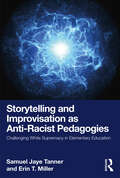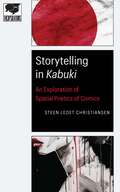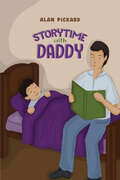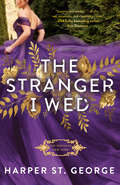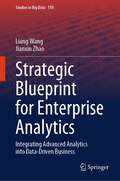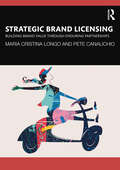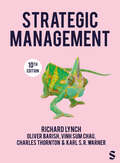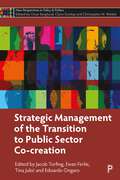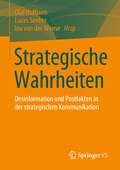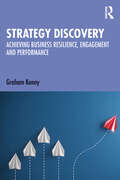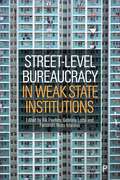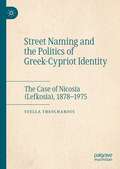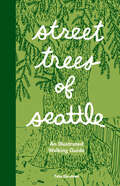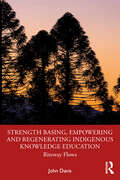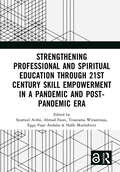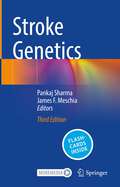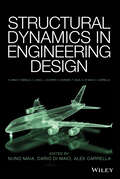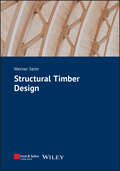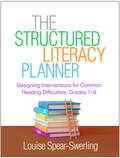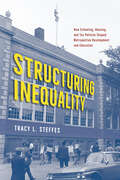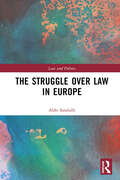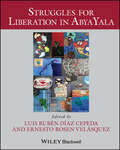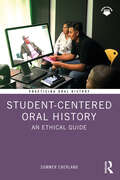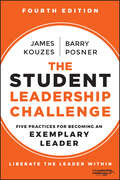- Table View
- List View
Storytelling and Improvisation as Anti-Racist Pedagogies: Challenging White Supremacy in Elementary Education
by Samuel Jaye Tanner Erin T. MillerThis book theorizes and describes the concept of transformative critical whiteness pedagogies that are rooted in theories and practices of improvisation. It shows how these pedagogies invite people, especially white people, into the urgent work of resisting the ongoing production and affirmation of white supremacy.Using the frameworks of storytelling and story analysis, this book uses narrative to invite the reader into ongoing work to design and make sense of teaching and learning about whiteness that would meaningfully account for a grapple with white supremacy. Chapter 1 offers the conceptual framework rooted in theories and practices of improvisation that allow for new ways to think about engaging whiteness in anti-racist pedagogies, which the authors name transformative critical whiteness pedagogies. Chapters 2–4 tell and analyze the stories that emerged out of this work to design and facilitate transformative critical whiteness pedagogies with white elementary students, white college students, and then black elementary students in the US. Chapters 5 and 6 discuss the challenges of developing and implementing transformative critical whiteness pedagogies in K-12 contexts. The final chapters offer a discussion of the improvisational ethos, as well as an overview of the authors’ ongoing work to engage people, especially white people, in getting smarter about whiteness.Using simple, straightforward language to address complex ideas about anti-racist pedagogies, this volume will be important reading for pre-service teachers and teacher educators in Critical Whiteness Studies, Critical Multicultural Education, Social Foundations of Education, Elementary Education, and Race and Culture Studies.
Storytelling in Kabuki: An Exploration of Spatial Poetics of Comics (Encapsulations: Critical Comics Studies)
by Steen Ledet ChristiansenSteen Ledet Christiansen&’s Storytelling in &“Kabuki&” explores the series created by David Mack—a slow, recursive narrative that focuses on the death of Kabuki and her past. The series ran from 1994 to 2004 in a variety of miniseries, one-shots, and spin-offs, rather than following a conventional American monthly release schedule. Most of the series explores different perspectives on the same event and adds background to Kabuki&’s past, usually through surreal sequences, dreams, and near-death experiences. The flexibility of comics&’ approach to chronology, space, focalization, narrative, and fictionality enabled Mack to produce an unusual experience. Kabuki tells a story that can only exist via comics. Christiansen analyzes the visual design of the series, a heterogeneous collection of styles depending on the story. To understand Kabuki, it is crucial to explore the visual styles, as well as the use of visual and spatial rhymes and mixed media forms. Because Kabuki employs a complex layering of focalizations, diegetic levels, and metafictional self-reflectivity that is rare in mainstream American comics, it utilizes a narrative poetics that focuses on constant repeating, restating, and returning to the same events.Kabuki&’s unique compositional layering allows Christiansen to provide a clear example of how comics work while also expanding on critical vocabulary, especially in terms of spatial poetics. By exploring spatial form, Christiansen illuminates and gives a critical framework to a different and underexamined aspect of comics.
Storytime with Daddy
by Alan PickardRory loved listening to stories and he always remembered the ones that Daddy read to him at bedtime. He wanted to know where stories came from. And he told Daddy that one day he would like to write stories. And that was why he couldn’t wait to start reading himself. Rory didn’t think that he would ever get tired of stories!
The Stranger I Wed (The Doves of New York #1)
by Harper St. GeorgeNew to wealth and to London high society, American heiress Cora Dove discovers that with the right man, marriage might not be such an inconvenience after all. . . .Cora Dove and her sisters&’ questionable legitimacy has been the lifelong subject of New York&’s gossipmongers and a continual stain on their father&’s reputation. So when the girls each receive a generous, guilt-induced dowry from their dying grandmother, the sly Mr. Hathaway vows to release their funds only if Cora and her sisters can procure suitable husbands—far from New York. For Cora, England is a fresh start. She has no delusions of love, but a husband who will respect her independence? That&’s an earl worth fighting for.Enter: Leopold Brendon, Earl of Devonworth, a no-nonsense member of Parliament whose plan to pass a Public Health bill that would provide clean water to the working class requires the backing of a wealthy wife. He just never expected to crave Cora&’s touch or yearn to hear her thoughts on his campaign—or to discover that his seemingly perfect bride protects so many secrets...But secrets have a way of bubbling to the surface, and Devonworth has a few of his own. With their pasts laid bare and Cora&’s budding passion for women&’s rights taking a dangerous turn, they&’ll learn the true cost of losing their heart to a stranger—and that love is worth any price.
Strategic Blueprint for Enterprise Analytics: Integrating Advanced Analytics into Data-Driven Business (Studies in Big Data #150)
by Liang Wang Jianxin ZhaoThis book is a comprehensive guide for professionals, leaders, and academics seeking to unlock the power of data and analytics in the modern business landscape. It delves deeply into the strategic, architectural, and managerial aspects of implementing enterprise analytics (EA) systems in large enterprises. The book is meticulously structured into three parts. Part 1 lays the foundation for adaptable architecture in EA. Part 2 explores technical considerations: data, cloud platforms, and AI solutions. The final part focuses on strategy execution, investment, and risk management. Acting as a comprehensive guide, the book enables the creation of robust EA capabilities that foster growth, optimize operations, and keep pace with EA's dynamic world. Whether readers are leaders harnessing data's potential, practitioners navigating analytics, or academics exploring this evolving domain, this book provides insights and knowledge to guide readers toward a thriving, data-driven future.
Strategic Brand Licensing: Building Brand Value through Enduring Partnerships
by Maria Cristina Longo Pete CanalichioThis book presents a roadmap for a brand licensing strategy to enable companies to leverage brand value and expand into other product categories or into different markets. Readers will understand both the risks and the benefits of partnerships, how to make the most of a brand's potential in the digital platform, and how to extend a product portfolio through established brands. Brand licensing can be of interest to many stakeholders, including large companies, entrepreneurs, retailers, agencies and even celebrities. This is also a relevant strategy for small and medium-sized enterprises that want to expand their business abroad, reconciling their limited size with their flexibility. Examples of long-standing partnerships are presented and analyzed, with detailed consideration of what has made them so successful.Through the presentation of case studies in the sectors particularly interested in brand licensing, including the art, character, entertainment, fashion, jewelry, sports and toys sectors, this book aims to highlight opportunities, limits and challenges from both the licensor and licensee’s perspectives. In particular, these case studies represent an effective basis for comparing different experiences and brand licensing strategies, allowing readers to understand both best practices and pitfalls to avoid when building an effective and enduring licensing program. Chapter objectives, summaries, key learning points and discussion questions reinforce understanding and aid reflection.Practical yet theoretically grounded, this book is particularly suitable for postgraduate, MBA and executive education students interested in strategic brand management, licensing strategy and brand expansion. This book can also serve as a valuable guide for professionals interested in expanding their brand portfolio.This book provides effective tools to evaluate the strategic side of brand licensing and the selection of the appropriate company to be a licensee. Online resources include PowerPoint slides, a test bank of exam questions, a case list and discussion questions.
Strategic Management
by Richard Lynch Oliver Barish Vinh Sum Chau Charles Thornton Karl S. WarnerTaking a truly international approach, Strategic Management offers you comprehensive coverage of all the core areas of business strategy in a reader-friendly way. Thoroughly updated and with the addition of four brand-new authors, the tenth edition features: • Balanced treatment of prescriptive and emergent models of strategic management. • Application of strategic theory to key areas such as technology and innovation, sustainability, entrepreneurial and public sector strategy. • Cutting-edge content on navigating change in the strategic environment, digital transformation strategies and the role of strategic groups. • 15 brand new case studies showcasing real-life examples from recognisable brands such as Coca-Cola, Airbnb, Apple, Tesla, Toyota, Alibaba, Samsung, Starbucks and UK banks, plus updated case material throughout. • A range of practical tools to support your learning, including summaries of key strategic principles, strategic project ideas, critical reflections, questions and further reading. Suitable for both undergraduate and postgraduate study. Professor Richard Lynch is Emeritus Professor of Strategic Management at Middlesex University, London. Dr Oliver Barish is Lecturer in Management at Birkbeck Business School, Birkbeck, University of London. Dr Vinh Sum Chau is Senior Lecturer in Strategy at Kent Business School, University of Kent. Dr Charles Thornton is Lecturer in Service Operations Management and Business Strategy at Plymouth Business School, University of Plymouth. Dr Karl Warner is Lecturer in Strategy at Adam Smith Business School, University of Glasgow.
Strategic Management
by Richard Lynch Oliver Barish Vinh Sum Chau Charles Thornton Karl S. WarnerTaking a truly international approach, Strategic Management offers you comprehensive coverage of all the core areas of business strategy in a reader-friendly way. Thoroughly updated and with the addition of four brand-new authors, the tenth edition features: • Balanced treatment of prescriptive and emergent models of strategic management. • Application of strategic theory to key areas such as technology and innovation, sustainability, entrepreneurial and public sector strategy. • Cutting-edge content on navigating change in the strategic environment, digital transformation strategies and the role of strategic groups. • 15 brand new case studies showcasing real-life examples from recognisable brands such as Coca-Cola, Airbnb, Apple, Tesla, Toyota, Alibaba, Samsung, Starbucks and UK banks, plus updated case material throughout. • A range of practical tools to support your learning, including summaries of key strategic principles, strategic project ideas, critical reflections, questions and further reading. Suitable for both undergraduate and postgraduate study. Professor Richard Lynch is Emeritus Professor of Strategic Management at Middlesex University, London. Dr Oliver Barish is Lecturer in Management at Birkbeck Business School, Birkbeck, University of London. Dr Vinh Sum Chau is Senior Lecturer in Strategy at Kent Business School, University of Kent. Dr Charles Thornton is Lecturer in Service Operations Management and Business Strategy at Plymouth Business School, University of Plymouth. Dr Karl Warner is Lecturer in Strategy at Adam Smith Business School, University of Glasgow.
Strategic Management of the Transition to Public Sector Co-Creation
by Jacob Torfing, Ewan Ferlie, Tina Jukić and Edoardo OngaroAs the practices of public governance are rapidly changing, so must the theoretical frameworks for understanding the creation of efficient, effective and democratic governance solutions. First published as a special issue of Policy & Politics journal, this book explores the role of strategic management, digitalisation and generative platforms in encouraging the co-creation of innovative public value outcomes. It considers why we must transform the public sector to drive co-creation and the importance of integrating different theoretical strands when studying processes, barriers and outcomes. This book lays out important stepping-stones for the development of new research into the ongoing transition to co-creation as a mode of governance.
Strategische Wahrheiten: Desinformation und Postfakten in der strategischen Kommunikation
by Olaf Hoffjann Lucas Seeber Ina von der WenseStrategische Kommunikation zielt mit ihren kontingenten Wirklichkeitsbeschreibungen seit jeher auf gesellschaftliche Wahrheitsmodelle. Wie häufig gesellschaftliche Wahrheitsmodelle auf strategische Kommunikationsbemühungen zurückgehen, auf Unwahrhaftigkeit beruhen und damit zumindest zeitweise zu strategischen Wahrheiten werden, zeigen eindrucksvoll zwischenzeitlich geglaubte Wahrheiten, die sich als Lüge entpuppt haben: von Walter Ulbrichts „Niemand hat die Absicht, eine Mauer zu errichten“ über Hitlers Tagebücher bis hin zu den Massenvernichtungswaffen im Irak. Die erfolgreichen Kampagnen der Brexiteers und von Donald Trump 2016 haben diesem Thema zu neuer und bislang ungeahnter Aufmerksamkeit verholfen. Während die Themen Desinformation und postfaktische Gesellschaft die Journalismus-, politische Kommunikations- und Medienethikforschung aktuell zu dominieren scheinen, ist das Schweigen der deutschsprachigen und internationalen PR- und Organisationskommunikationsforschung auffällig. Dies ist umso bemerkenswerter, weil die PR-Wissenschaft in der Vergangenheit immer wieder versucht hat, ihren Gegenstand zu schärfen, indem sie sich am Begriff der Propaganda abgearbeitet hat. Daraus müsste eigentlich eine Affinität für das Thema Desinformation resultieren. Aber genau das Gegenteil ist offensichtlich der Fall: Hat sich die PR-Wissenschaft gerade deshalb nicht mit Desinformation beschäftigt, weil sie sich so dezidiert von Propaganda und darin eingeschlossenen desinformierenden und manipulativen Techniken abgrenzen will? Was sind die Gründe hierfür? Glauben wir, bereits alles zum Thema gesagt zu haben? Liegt dies daran, dass sich die PR- und Organisationskommunikationsforschung seit jeher vor allem für Unternehmen und weniger für politische und Non-Profit-Organisationen interessiert? Oder fühlen wir uns hier schlicht und ergreifend nicht zuständig? Es scheint offenkundig höchste Zeit zu sein, sich wieder eingehend mit Fragen der Desinformation aus der Perspektive der strategischen Kommunikationsforschung zu befassen. Die Beiträge des Tagungsbandes fokussieren hierzu auf neue theoretische Perspektiven, normative Bewertungen und empirische Befunde.
Strategy Discovery: Achieving Business Resilience, Engagement and Performance
by Graham KennyPersonal, useful, actionable and grounded in research, this book will shift your thinking from "strategy development" to "strategy discovery" to enable you to deal with today’s business challenges, engage your staff and boost your business performance. Management teams and boards are facing disruption on all sides, from morphing customer preferences to the COVID pandemic to climate change. At the same time they are floundering in strategy confusion with too many concepts and not enough clarity. In this book, strategy expert and regular Harvard Business Review author Graham Kenny releases managers and directors from their strategy haze. His simple and effective framework allows managers to navigate the current maze of ideas and approaches and maximize their competitive advantage. Kenny’s readable style is equally effective: each chapter begins with an engaging story, then builds on this with cases, client examples, sidebars and more, ending with a series of action points to provide a pathway to success. CEOs, senior-level and middle managers across all functions and sectors, including private, public and not-for-profit organizations, who discuss and set strategy for their organization or business unit will appreciate the articulated framework, illustrative anecdotes and positive encouragement this book offers.
Street-Level Bureaucracy in Weak State Institutions
by Rik Peeters, Gabriela Lotta, and Fernando Nieto-MoralesIn this book, street-level bureaucracy scholars from South Asia, sub-Saharan Africa, the Middle East, and Latin America analyse the conditions that shape frontline work and citizens´ everyday experience of the state. Institutional factors such as political clientelism, resource scarcity, social inequality, job insecurity, and systemic corruption affect the way street-level bureaucrats enforce rules and implement policies. Inadvertently, they end up implementing inequities in citizens’ access to rights and services — despite efforts to repair organisational deficiencies and broker relations between vulnerable citizens and a distant state. This book illuminates these realities and challenges and provides unique insights into critical themes such as resource scarcities, bureaucratic corruption, control practices, and the complexities of dealing with vulnerable population groups.
Street Naming and the Politics of Greek-Cypriot Identity: The Case of Nicosia (Lefkosia), 1878–1975
by Stella TheocharousThis book is the first to explore street names and street-naming in the formation of a Greek-Cypriot identity in the cityscape of Nicosia between 1878 and 1975. Rather than treating toponymy as a direct linguistic act of spatial orientation, the book approaches street-naming as a contested practice involving those shared symbols and representations used to depict official history and collective identity as part of a political process. It considers how street names are part of the symbolic politics of space, and how authorities transformed the streets of Nicosia into arenas of struggle for the control of symbolic and material space. It documents historical efforts over the course of a century to impose a ‘geography of forgetting’ to buttress national identity and to cast out the ‘other’ from space — both literally and symbolically — so as to achieve territorial dominance and political legitimacy. The book is another step towards the development of a global perspective on the critical study of street-naming, thereby refining and expanding our knowledge of the political dynamics involved in the process. In their commemorative capacity, street names belong to the politics of public memory and identity.
Street Trees of Seattle: An Illustrated Walking Guide
by Taha EbrahimiThe majestic trees of Seattle's neighborhoods take center stage in this illustrated and informative walking guide. Want to discover which neighborhood has the highest concentration of cherry street trees when cherry blossoms are at their peak?Eager to stroll down the only street lined with western red cedars?Curious how monkey puzzle trees made their way to the city?Using data visualization as a starting point, the author takes readers on a tour of existing street trees throughout Seattle's neighborhoods and iconic parks through charming illustrations and maps. In the process, she educates readers on the history of the trees and the city, and offers up sketches of trees, leaves, and leaflets to identify trees throughout 33 different neighborhoods. The most notable of each species are highlighted, so urban adventurers can fully appreciate their surroundings or design their own walking routes to experience these natural wonders in their favorite areas of the city.The book is organized alphabetically by neighborhood and each area: Showcases a species of treeIncludes a history of the tree and neighborhoodOffers maps and callouts for spotting the best street specimens In an increasingly digital world, the book invites readers to slow down and embrace an analog approach to tree-spotting during their urban meanderings.
Strength Basing, Empowering and Regenerating Indigenous Knowledge Education: Riteway Flows
by John DavisStrength Basing, Empowering and Regenerating Indigenous Knowledge Education demonstrates how to bring Indigenous Knowledges to the forefront of education practice and provides educators with the tools to enact culturally responsive curricula and pedagogies, ensuring positive educational outcomes for Aboriginal and Torres Strait Islander children and students. In this book, John Davis presents Indigenous Knowledges – ways of doing, creating, and learning – combined with contemporary education practice, to develop a culturally responsive pedagogy that builds on the strengths that Indigenous Australian students bring to the classroom. Setting Cultural Proficiency as the benchmark, the book offers educators a lens through which to review their education practice. It moves beyond the deficit model of Indigenous education by challenging non-Indigenous educators to reflect on personal biases and to raise their expectations of Indigenous students. Not ‘tacked on’ to an existing curriculum, or specific to a single school term or unit of learning, Riteway places Indigenous Knowledges at the centre of education. The approach is holistic and adaptable to any educational context, from the early years right through to tertiary education. Providing a roadmap toward transformational education for Aboriginal and Torres Strait Islander children and students, this book will be essential reading for pre- and in-service educators alike.
Strengthening Professional and Spiritual Education through 21st Century Skill Empowerment in a Pandemic and Post-Pandemic Era: Proceedings of the 1st International Conference on Education (ICEdu 2022), September 28, 2022, Malang, Indonesia
by Syamsul Arifin Ahmad Fauzi Triastama Wiraatmaja Eggy Fajar Andalas Nafik MuthohirinDiscover a treasure trove of knowledge in the proceedings of the First International Confer-ence on Education (ICEdu). This meticulously curated collection of research papers delves into the transformative landscape of education in the 21st century, offering insights, solutions, and inspiration for educators, researchers, and policymakers alike.Explore a diverse range of subject areas, from pedagogical innovations to the challenges of digital learning and the impact of the COVID-19 pandemic on education. With 28 scholarly papers contributed by experts from around the world, this volume offers a comprehensive un-derstanding of the multifaceted issues in contemporary education.Whether you're an academic seeking fresh perspectives or an educator navigating the com-plexities of modern pedagogy, these proceedings provide invaluable guidance. Join us in shap-ing the future of education by harnessing the power of 21st-century skills, professional devel-opment, and spiritual growth.This book is an essential resource for anyone passionate about the advancement of education in the pandemic and post-pandemic era.The Open Access version of this book, available at http://www.taylorfrancis.com, has been made available under a Creative Commons Attribution-Non Commercial-No Derivatives (CC-BY-NC-ND) 4.0 license. Funded by Universitas Muhammadiyah Malang, Indonesia.
Stroke Genetics
by Pankaj Sharma James F. MeschiaThis revised, expanded third edition updates the reader on this fast moving field as well providing an overall understanding of the genetics of complex diseases by using stroke as a paradigm. The reader will gain a comprehensive understanding of cerebrovascular genetics including the epidemiological evidence for the genetic basis of ischemic and hemorrhagic stroke, knowledge of its molecular basis from association, linkage and recent genome-wide studies, and also monogenic disorders. Finally, the legal and ethical complexities in dealing with these issues are discussed.Stroke Genetics is a valuable resource for neurologists, stroke physicians, hypertension specialists, internists, clinical pharmacologists and those in training, as well as researchers in the field of disease genetics. Each chapter now contains teaching/training MCQs to help with retention of information learnt from each chapter and this will be of considerable use to those training or about to the examined inthe field of inherited stroke.Additional questions via app: Download the Springer Nature Flashcards app for free and use exclusive additional material to test your knowledge.
Structural Dynamics in Engineering Design
by Nuno M. M. Maia Dario Di Maio Alex Carrella Francesco Marulo Chaoping Zang Jonathan E. Cooper Keith Worden Tiago A. N. SilvaWorld-class authors describe and illustrate how structural dynamics is applied to the engineering design process Structural Dynamics in Engineering Design covers the fundamentals of structural dynamics and its application to the engineering design process, providing all of the necessary information to implement an optimal design process. Each of its seven chapters is written by an expert in the field and provides the reader with the structural dynamic theoretical background and its more practical aspects for the implementation of an advanced design capability. The first three chapters are dedicated to the underlying theory of the three main processes: the fundamentals of vibration theory, the basis of experimental dynamics and the main numerical analysis tools (including reference to the finite element method). Having laid the foundation of the design philosophy, the following three chapters present the reader with the three disciplines of identification, nonlinear analysis and validation/updating. The final chapter presents some applications of the approach to real and complex engineering cases. Key features: Takes a multi-disciplinary approach and contains critical information on theory, testing and numerical analysis for structural dynamics. Includes a chapter on industrial applications (including aircraft design and ground vibration testing), which illustrates the design process and explains how structural dynamics is applied at different stages. The book is a must-have for researchers and practitioners in mechanical and aerospace engineering (in particular test engineers, CAE analysts and structural dynamicists), as well as graduate students in mechanical and aerospace engineering departments.
Structural Timber Design
by Werner SeimStructural Timber Design Timber construction has been one of the most innovative areas of the building industry for several years. The speed with which new products are introduced into practical application is almost breathtaking compared to the other construction materials in the building industry. As a result, timber construction is continuously increasing its market share in commercial buildings and hall structures, and even in multi-storey construction for residential and office buildings. This book provides essential knowledge and skills required for the design, detailing, and construction of timber structures. Special emphasis is placed on the specific features of timber and wood-based materials compared to other construction materials. This concerns the numerous advantages, as e.g. the comparatively low weight, the good workability of the high-performance material and the large variety of assembling technologies, but also the challenges resulting from the material anisotropy and from the susceptibility to natural pests. In each chapter the essential phenomena are explained first and then brought into connection with code regulations. This aims to support the basic understanding of the interrelations and dependencies in timber engineering, which is the fundamental basis of creative engineering.
The Structured Literacy Planner: Designing Interventions for Common Reading Difficulties, Grades 1-9
by Louise Spear-SwerlingStructured Literacy (SL) approaches are increasingly recognized as the gold standard for teaching struggling readers. This highly practical book walks educators through designing SL interventions for students with common types of reading difficulties--word reading, comprehension, or a combination of both. Louise Spear-Swerling offers tools for assessing students' reading profiles and tailoring SL to their needs. In a convenient large-size format, the volume is packed with case studies, sample lesson plans addressing both early and advanced stages of reading, instructional activities, and application exercises for teachers. A chapter on English language structure presents essential foundations for implementing SL effectively. The companion website features a knowledge survey about language structure (with answer key), as well as downloadable copies of the book's 14 reproducible forms. See also Louise Spear-Swerling's edited volume, Structured Literacy Interventions: Teaching Students with Reading Difficulties, Grades K–6, which surveys SL interventions across all components of literacy.
Structuring Inequality: How Schooling, Housing, and Tax Policies Shaped Metropolitan Development and Education
by Tracy L. SteffesHow inequality was forged, fought over, and forgotten through public policy in metropolitan Chicago. As in many American metropolitan areas, inequality in Chicagoland is visible in its neighborhoods. These inequalities are not inevitable, however. They have been constructed and deepened by public policies around housing, schooling, taxation, and local governance, including hidden state government policies. In Structuring Inequality, historian Tracy L. Steffes shows how metropolitan inequality in Chicagoland was structured, contested, and naturalized over time even as reformers tried to change it through school desegregation, affordable housing, and property tax reform. While these efforts had modest successes in the city and the suburbs, reformers faced significant resistance and counter-mobilization from affluent suburbanites, real estate developers, and other defenders of the status quo who defended inequality and reshaped the policy conversation about it. Grounded in comprehensive archival research and policy analysis, Structuring Inequality examines the history of Chicagoland’s established systems of inequality and provides perspective on the inequality we live with today.
The Struggle over Law in Europe (ISSN)
by Aldo SandulliThis book examines the role of law in Europe at a time when economic policies have become dominant not only on this continent but globally. Can law be seen as a mere infrastructure? Or does it contribute to defining the social and legal order through its own inherent rules? If the second hypothesis is true, what might these rules be, and how may they be identified? Lastly, to what extent can agreeing a definition of the role of law affect the future of Europe? With the Next Generation European Union, the EU has introduced an unprecedented investment plan for economic recovery and resilience. In doing so, it has become the most important financial intermediary on the continent. But is this simply the prelude to a European economic and financial revival, or does it also aim to strengthen the European legal order in social, political, and constitutional terms? This book argues that the role of law in Europe should be to achieve a balanced relationship between freedom and solidarity; encouraging economic competition, but also social cohesion. Analyzing the role of law in the project of European integration, it maintains that law should be more than an infrastructure for finance and economics, showing how it can act as a guide and a binding force to achieve a more balanced relationship between economics, politics, and law. This book will be of interest to scholars in the fields of public law, European law, law and economics, the philosophy of law, legal history, political theory, and political science, as well as others concerned with the future of European integration.
Struggles for Liberation in Abya Yala
by Luis Rubén Díaz Cepeda Ernesto Rosen VelásquezPresents struggles for liberation in the Americas from the perspectives of structural victims Struggles for Liberation in Abya Yala explores the ways people occupying different positionalities respond to various catastrophes while discussing how collective processes of struggle make new meanings and create new forms of relationality and subjectivity. Bringing together contributions by a diverse panel of well-established voices and rising scholars, this provocative volume challenges readers to resist, take direct collective action, organize, protest, and give proper uptake to social movements that fight against injustice and life-threatening conditions. Operating primarily within the context of “Abya Yala” — the term deployed by indigenous peoples to refer to the US, Latin America, and the Caribbean — the volume demonstrates and advances the explanatory and normative power of Philosophy of Liberation and the Decolonial Turn through theoretical analysis of current social changes unfolding in the Americas. Throughout the book, academic scholars and on-the-ground activists illustrate the reach, impact, and implications of radical social transformations that support victims of the system. Offering perspectives from the people who have chosen to rebel and act in solidarity against the system that oppresses them, Struggles for Liberation in Abya Yala: Addresses different struggles for social justice in the US, México and Latin America Draws from philosophical tradition with influence in Africana philosophy, feminism, critical race theory, ethics, and political philosophy Tasks readers to fight for reparations, stand in solidarity with marginalized and indigenous peoples, and abolish dispossession Critiques the capitalist and colonial relationships that facilitate the exploitation of large segments of the population Promotes social mobilization through education and the decolonization of Westernized university and educational practices An urgent call to action for all those seeking to fundamentally change the world, Struggles for Liberation in Abya Yala is a must-read for undergraduate and graduate students, educators and university lecturers, academic researchers and scholars, social and political activists, policymakers, journalists and media professionals, and general readers who are committed to liberation.
Student-Centered Oral History: An Ethical Guide (Practicing Oral History)
by Summer CherlandStudent-Centered Oral History explores the overlaps of culturally relevant teaching, student-centered teaching, and oral history to demonstrate how this method empowers students, especially those from historically underrepresented communities. With tangible tools like lesson plans and reflection sheets, available to download as eResources from the book's website, each interactive chapter is applicable to classrooms and age groups across the globe. Educators from all levels of experience will benefit from step-by-step guides and lesson plans, all organized around guiding questions. These lessons coach students and educators from start to finish through a student-centered oral history. Background research, historical context, cultivating a culture of consent, analysis, promotion, and gratitude are among the many lessons taught beyond writing questions and interviewing. With a specific focus on the ethics influencing a teacher’s role as guide and grader of a student-centered oral history, this book also highlights successful approaches across the world of students and teachers discovering oral history. These examples reveal how student-centered oral history empowers academic achievement, radicalizes knowledge, develops relationships, and promotes community engagement. This book is a useful tool for any students and scholars interested in oral history in an educational setting.
The Student Leadership Challenge: Five Practices for Becoming an Exemplary Leader (J-B Leadership Challenge: Kouzes/Posner)
by James M. Kouzes Barry Z. PosnerA brand new edition of the bestselling book that helps students and young people to develop critical leadership skills The Student Leadership Challenge is based on four decades of research on what people are doing when at their personal-best as leaders. With an approach tailored specifically to young and emerging leaders, this guide introduces The Five Practices of Exemplary Leadership operating system, incorporating stories of leadership development from real students, as well as reflective and critical thinking activities at the end of each chapter. Readers will have opportunities to engage in each of The Five Practices, building leadership skills that translate to real world applications. This fourth edition has been updated with new stories about topics critical to today's youth, including climate change, social justice, mental health, and virtual learning. Included with the book is access to the online Student Leadership Practices Inventory, so readers can achieve insight into their current leadership skills. Learn The Five Practices of Exemplary Leadership, and how they help you succeed while in school and in life Get inspired by stories of students around the world who exhibit exemplary leadership Practice critical leadership behaviors and engage in thought-provoking reflections Assess your own potential with the Student Leadership Practices Inventory As a result of reading and interacting with The Student Leadership Challenge, readers will emerge with a concrete leadership framework and new skills that they can take with them, wherever the future leads.
